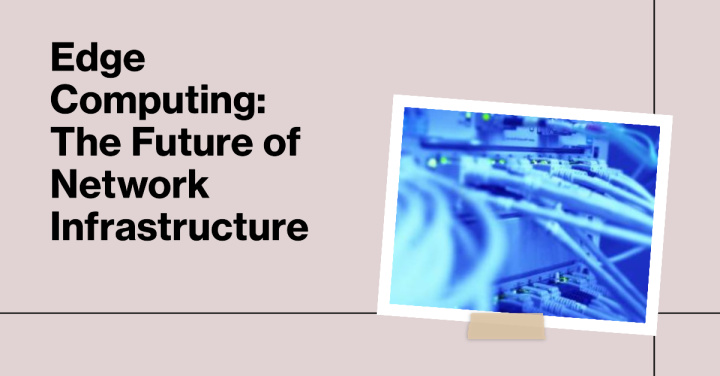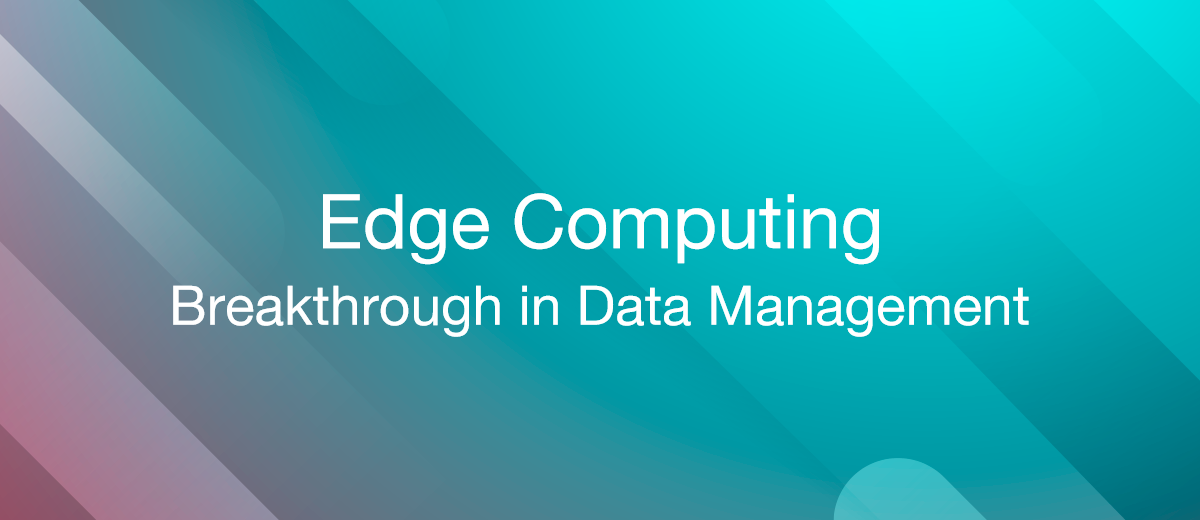Edge Computing: a Breakthrough in Data Management and Efficiency
As we plunge deeper into the era of big data, the ability to manage, process, and leverage this data effectively becomes a core determinant of success for organizations. Traditional data management systems are facing challenges coping with unprecedented data volumes. However, a novel solution – edge computing – is emerging as a breakthrough. This technology brings data processing and analytics closer to the source of data, thereby increasing efficiency and reducing latency. This article explores the concept of edge computing, its impact on data management, and its efficiency-enhancing benefits, along with the challenges faced in implementation and potential solutions.
What is Edge Computing
Edge computing signifies a paradigm shift in the realm of data processing. This transformative approach involves transferring part of the data processing workload closer to the source of information, usually at the network's periphery or 'edge'. This model helps manage the massive amounts of data generated by devices on the Internet of Things (IoT) ecosystem. By processing information near its origin, latency is significantly reduced, thus accelerating response times and fostering more efficient data management. To fully comprehend this novel methodology, it's vital to juxtapose it against its predecessor, cloud computing, which we will discuss in the subsequent section.
Understanding edge computing

Edge computing is an
advanced architecture designed to alleviate some of the constraints traditional
cloud-based data processing models face. By positioning computational resources
closer to data sources, be they IoT devices or
network switches, edge computing facilitates rapid data processing and prompt
decision-making.
How edge computing works? In a typical setup, smart devices or edge servers perform the initial data processing. Instead of sending all raw data to the cloud, these edge components analyze, filter, and process data locally, transmitting only necessary information back to the cloud or central data center. This approach mitigates latency, reduces bandwidth requirements, and enhances overall network efficiency.
One of the key strengths of edge computing lies in its decentralized nature. By reducing the dependency on a central location for data processing, edge computing ensures smoother operations even in scenarios where connectivity might be unstable. It's particularly beneficial in real-time applications where prompt data processing is of utmost importance, such as autonomous vehicles, smart homes, or telemedicine. However, to truly appreciate the edge computing paradigm, a comparison with its cloud counterpart becomes essential.
Edge computing vs cloud computing
While both edge and cloud computing serve as powerful tools in data management, they differ significantly in terms of their architecture and operation. Cloud computing centralizes data processing and storage, necessitating data transmission over long distances, which can cause latency and demand considerable bandwidth.
Contrarily, edge computing disperses processing tasks, situating them closer to data sources. This decentralized model facilitates real-time processing by minimizing latency and conserving bandwidth. Nevertheless, it doesn't mean that edge computing replaces the cloud. Instead, they function in tandem, offering an optimized blend of rapid local data processing and scalable, centralized storage and further analysis.
However, the choice between edge and cloud computing hinges on the specific use case. For instance, edge computing is beneficial in scenarios demanding low latency and real-time analytics, such as autonomous vehicles or industrial automation. In contrast, cloud computing remains ideal for tasks requiring substantial computational power and storage capacity, such as big data analysis and machine learning model training. Therefore, understanding the strengths and trade-offs of each approach is key to determining the best solution for a given context.
Why Edge Computing is a Breakthrough in Data Management
The proliferation of data-rich technologies, such as IoT devices and machine learning, has emphasized the need for more efficient data management strategies. Edge computing emerges as a groundbreaking solution to this challenge, reshaping the traditional landscape of data processing. Here's why:
- Reduced latency. By conducting data processing closer to the source, edge computing substantially diminishes latency. Quick response times are crucial in numerous sectors, from autonomous vehicles to real-time financial transactions.
- Bandwidth conservation. With localized data processing, edge computing reduces the volume of data that needs to be transmitted over the network, thereby saving bandwidth and enhancing network performance.
- Enhanced privacy and security. By processing sensitive data on-site and sending only necessary information to the cloud, edge computing can bolster data privacy and security. This approach is particularly vital in industries handling sensitive data, such as healthcare or finance.
- Reliability. Edge computing operates even when cloud connectivity is unstable or nonexistent, providing an additional layer of operational resilience.
- Real-time analytics. The capacity to analyze data in real-time makes edge computing essential for applications requiring immediate insights, such as predictive maintenance in manufacturing.
Edge computing is, undoubtedly, a major game-changer in data management. Its ability to offer improved speed, efficiency, security, and reliability positions it as a crucial component in the data-driven landscape of the future.
Real-life Applications of Edge Computing
Edge computing, with its transformative features, is finding applications in a multitude of sectors. Let's take a look at a few edge computing examples:
- Autonomous vehicles. With edge computing, self-driving cars can process real-time data on-the-go, aiding in decision-making. Traffic conditions, pedestrian movement, and weather data can all be analyzed instantly, ensuring safer and more efficient navigation.
- Smart cities. Edge computing plays a pivotal role in managing urban infrastructure. Real-time processing of data from sensors deployed throughout a city allows for efficient traffic management, waste management, and energy consumption control.
- Manufacturing. In industrial environments, edge computing enables predictive maintenance by processing data from machines to detect potential faults before they result in substantial downtime.
- Healthcare. In telemedicine and remote patient monitoring, edge computing provides real-time analysis of vital signs, enabling prompt response to emergencies.
- Retail. Retailers use edge computing for real-time inventory tracking and customer behavior analysis, leading to improved customer experience and operational efficiency.
These edge computing use cases underscore the versatility of edge computing and its capacity to revolutionize various sectors. As technology continues to evolve, we can expect to see an even broader adoption of edge computing, further facilitating our transition to a truly connected world.
Benefits of Edge Computing
With its innovative approach to data management, edge computing brings a multitude of advantages across diverse sectors. What are the benefits of edge computing? We list some of the most significant:
- Decreased latency. Edge computing drastically cuts down data transmission time, enabling faster decision-making and real-time analytics.
- Bandwidth efficiency. By processing data closer to the source, edge computing minimizes network congestion, leading to better use of available bandwidth.
- Improved privacy and security. Edge computing can limit the exposure of sensitive data by processing it on-site and transmitting only the necessary information to the cloud, thus enhancing data security.
- Operational resilience. The distributed nature of edge computing ensures continuous operation even when network connectivity is compromised, contributing to system reliability.
- Scalability. Edge computing provides a scalable solution to handle the growing data loads generated by an increasing number of connected devices.
- Energy efficiency. By reducing data transmission over long distances, edge computing can contribute to energy conservation.
Edge computing, therefore, serves as a powerful tool in the modern digital landscape. It not only improves the speed and efficiency of data processing but also enhances data security, system reliability, and scalability, all crucial factors in an increasingly interconnected world.
Challenges and Solutions to Implementing Edge Computing
While edge computing offers remarkable benefits, it also poses some unique challenges. Let's examine some of these hurdles and potential solutions:
- Security risks. The distributed nature of edge computing may expose more attack surfaces for potential threats. However, implementing robust security protocols and regular firmware updates can mitigate these risks.
- Data governance. With data being processed at multiple locations, maintaining data integrity and compliance becomes challenging. Employing standardized procedures and advanced data management tools can help overcome this.
- System complexity. Managing a multitude of edge devices could result in complex system management. Deploying automated management tools and utilizing AI can streamline operations.
- Hardware limitations. Edge devices may face constraints in terms of processing power and storage. Solutions like efficient data compression techniques and edge-to-cloud integration can help address these limitations.
Even with these challenges, the adoption of edge computing is accelerating thanks to the continuing advancements in technology that address these issues. Thus, despite certain obstacles, edge computing holds the promise of revolutionizing how we process and manage data in our increasingly connected world.
Conclusion
Edge computing is indeed reshaping the landscape of data management, offering numerous benefits such as reduced latency, improved network efficiency, enhanced security, and operational resilience. While its implementation does present certain challenges, continual technological advancements offer promising solutions. Its real-life applications underscore its transformative potential across various sectors, contributing to the growing momentum towards a more efficient, interconnected world. As the digital universe continues to expand, the future of edge computing is undoubtedly very promising. They will play a key role in navigating this data-intensive landscape, proving themselves to be a vital component of our digital world.
Apix-Drive is a simple and efficient system connector that will help you automate routine tasks and optimize business processes. You can save time and money, direct these resources to more important purposes. Test ApiX-Drive and make sure that this tool will relieve your employees and after 5 minutes of settings your business will start working faster.

